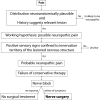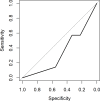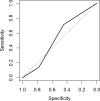Predictive value of a diagnostic block in focal nerve injury with neuropathic pain when surgery is considered
- PMID: 30208078
- PMCID: PMC6135496
- DOI: 10.1371/journal.pone.0203345
Predictive value of a diagnostic block in focal nerve injury with neuropathic pain when surgery is considered
Abstract
Object: In patients with focal nerve injury and neuropathic pain cutting the nerve to obtain permanent pain reduction can be considered. Surgery is indicated only if a diagnostic nerve block provides temporary pain relief. We evaluated the predictive value of a block on the outcome of surgery.
Methods: In total, three blocks were performed at two week intervals. Patients were blinded to injections containing lidocaine 1% and a placebo was included. Surgery was offered regardless of the effect of the blocks. Twenty-four patients received 72 blocks. Sixteen patients opted for surgery, 5 patients refrained from surgery, and in 3 the blocks provided permanent pain relief. The predictive ability of the block on the outcome of surgery was assessed by calculating the area under a Receiver Operating Characteristic curve (AUC).
Results: The AUC of the first lidocaine block was 0.35 with a 95% confidence interval from 0.077 to 0.62. At 95% confidence (two-sided), the AUC is less than 0.62, and hence the predictive ability of the block was poor. The outcome of the second lidocaine block and saline block did not change the conclusion of the first block.
Conclusions: We conclude that the use of blocks to select patients for surgery should be critically appraised.
Perspective: A pain relieving response to one open block is currently considered mandatory before patients with focal nerve injury and neuropathic pain are offered surgery. Blinded blocks including a placebo show that responses for selection should be carefully interpreted because they may not be as predictive as generally presumed.
Conflict of interest statement
The authors have declared that no competing interests exist.
Figures







Similar articles
-
Efficacy and safety of high concentration lidocaine for trigeminal nerve block in patients with trigeminal neuralgia.Int J Clin Pract. 2008 Feb;62(2):248-54. doi: 10.1111/j.1742-1241.2007.01568.x. Epub 2007 Nov 23. Int J Clin Pract. 2008. PMID: 18036166 Clinical Trial.
-
Adjuvant administration of hypertonic saline in lumbar epidural intervention may be associated with successful response in patients with probable neuropathic radicular pain Screened by Douleur Neuropathique 4.Int J Med Sci. 2021 May 17;18(12):2736-2742. doi: 10.7150/ijms.59695. eCollection 2021. Int J Med Sci. 2021. PMID: 34104106 Free PMC article.
-
Refractory occipital neuralgia: preoperative assessment with CT-guided nerve block prior to dorsal cervical rhizotomy.AJNR Am J Neuroradiol. 2003 Nov-Dec;24(10):2105-10. AJNR Am J Neuroradiol. 2003. PMID: 14625243 Free PMC article.
-
[Localized neuropathic pain--5% lidocaine medicated patch as a first-line treatment and as add-on therapy: literature review and personal experience].Minerva Med. 2014 Jun;105(3):177-95. Minerva Med. 2014. PMID: 24988084 Review. Italian.
-
Perineural Liposomal Bupivacaine Is Not Superior to Nonliposomal Bupivacaine for Peripheral Nerve Block Analgesia.Anesthesiology. 2021 Feb 1;134(2):147-164. doi: 10.1097/ALN.0000000000003651. Anesthesiology. 2021. PMID: 33372953
Cited by
-
[The EAN-NeuPSIG guideline on the diagnosis of neuropathic pain-a summary].Schmerz. 2024 Apr 11. doi: 10.1007/s00482-024-00806-0. Online ahead of print. Schmerz. 2024. PMID: 38602515 Review. German.
-
The role of ultrasound-guided perineural injection of the tibial nerve with a sub-anesthetic dosage of lidocaine for the diagnosis of tarsal tunnel syndrome.Front Neurol. 2023 Apr 17;14:1135379. doi: 10.3389/fneur.2023.1135379. eCollection 2023. Front Neurol. 2023. PMID: 37139063 Free PMC article.
-
Management of chronic knee pain caused by postsurgical or posttraumatic neuroma of the infrapatellar branch of the saphenous nerve.J Orthop Surg Res. 2021 Jul 21;16(1):464. doi: 10.1186/s13018-021-02613-0. J Orthop Surg Res. 2021. PMID: 34289862 Free PMC article.
References
-
- Attal N, Bouhassira D. Pharmacotherapy of neuropathic pain: which drugs, which treatment algorithms? Pain 2015. April;156 Suppl 1:S104–S114. - PubMed
Publication types
MeSH terms
Substances
LinkOut - more resources
Full Text Sources
Other Literature Sources
Medical

